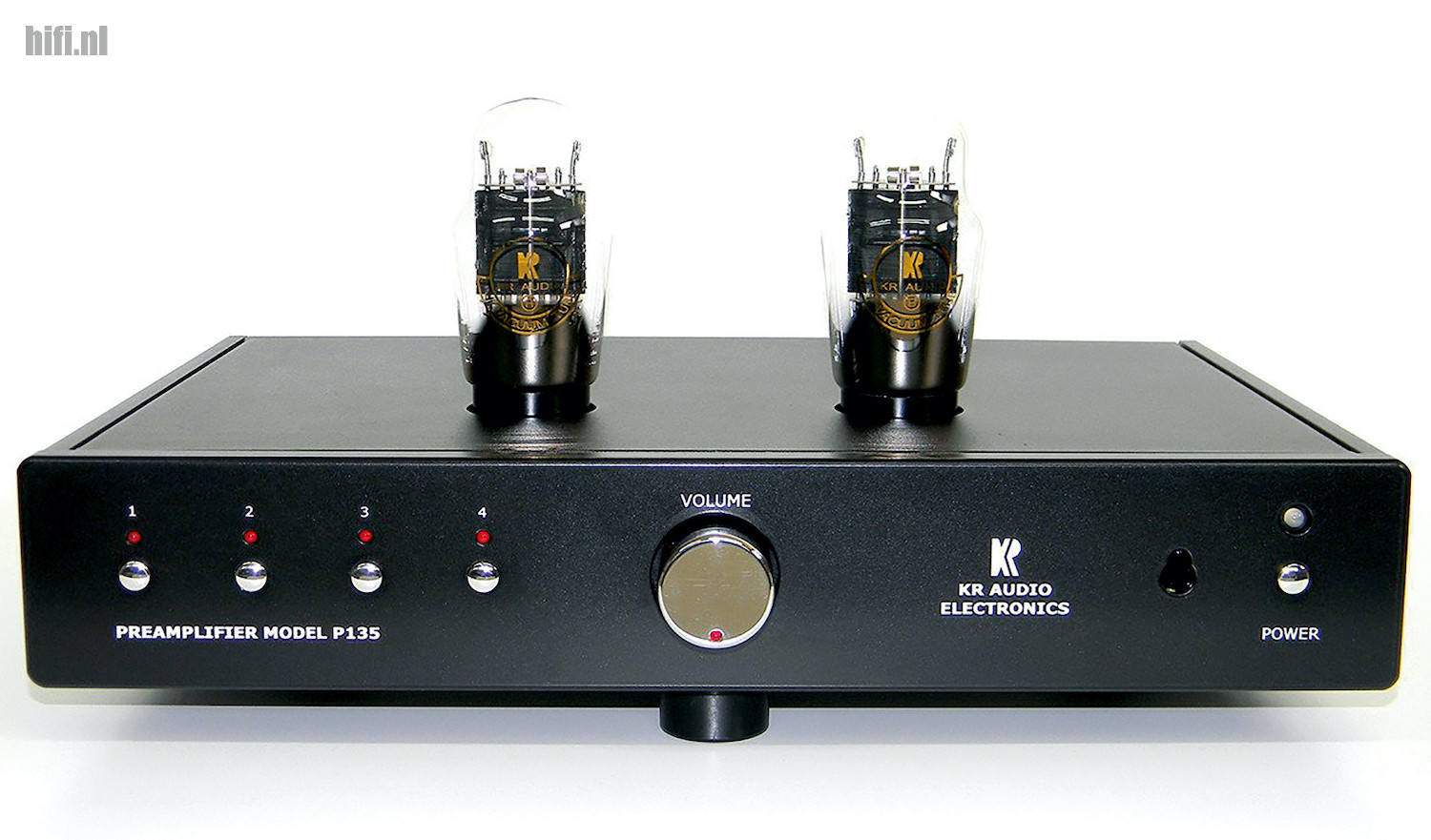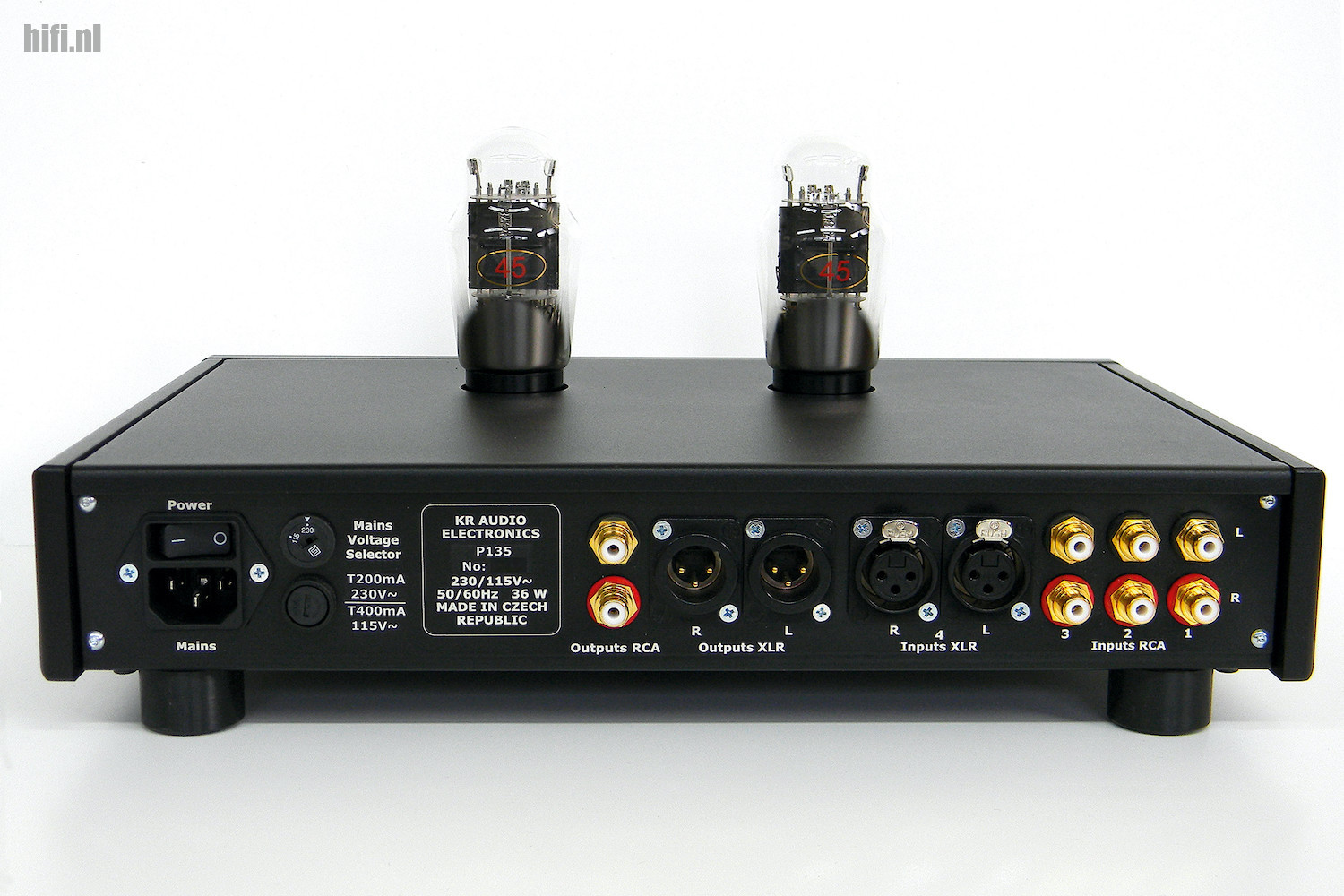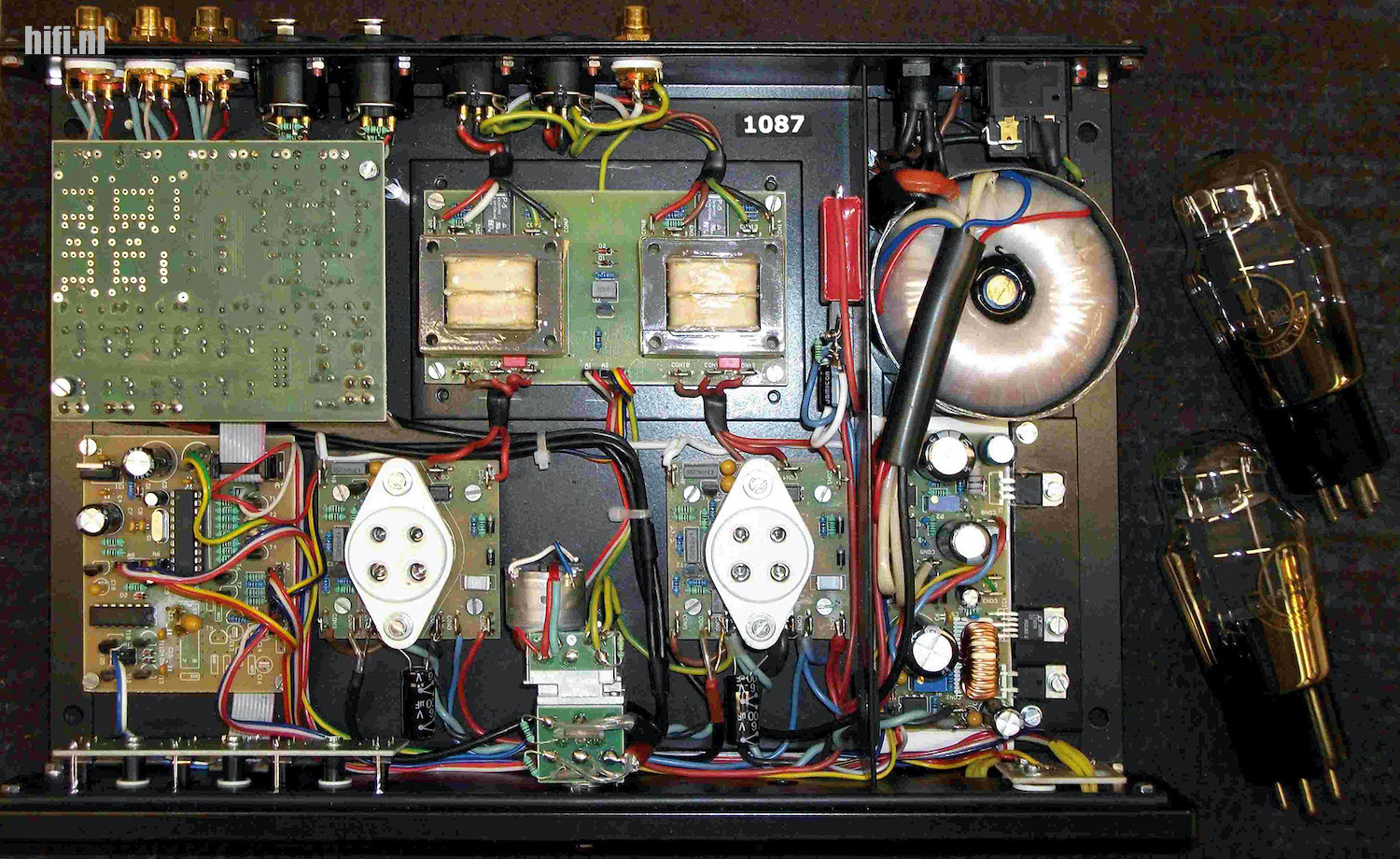
Sometimes, reviewing audio components is a serious and exhausting job. Therefore it would be reasonable to shift your retirement to an earlier age. The age of forty would be convenient. The problems involve lifting heavy power amplifiers and build up some defense against too colorful and enthousiastic marketing insights. Cables based on quantum physics and weird architectures promising transcedent experiences when listening to music. But, there are many audio companies building decent products and are humble and honest in their marketing approach. KR Audio Electronics from the Chech republic is an example. Still located in the old Tesla factory, they shipped the new P135 pre amplifier to the listening rooms, located in the Amsterdam metropolitan area.
Deze review in het Nederlands? Klik hier
It’s probably difficult to build a good performing pre amplifier. Nowadays, many power amplifiers are providing first class listening experiences. But when you connect the same brand matching pre amp, the performance is going down. As a consumer, the only choice is to get back to pre amps with a reputation. While it’s impossible to mention all the great pre amps, in the listening room were examples that made impressive sounds. Think about the Marantz 7T, the Marantz 3600 en 3200, the Audio Research SP3, SP10 and LS28, the Spectral pre amps, Cello and Krell KSL, the Dynaco PAS-3x, Hafler DH-101 and the Audiomaster mono pre-amps. The Audiomasters, from the UK, are basically mono chassis and are from the era when it was common to listen to mono records and radio. With the dawn of stereo, people were combining two mono pre-amps, feeding two mono power chassis or the upcoming stereo power amplifiers.
The Audiomasters were equipped with a stunning red metal enclosure and a half translucent acryl front panel. Large white knobs and the nice front panel function lighting are pretty characteristic for these charming beasts. These amplifiers are very rare. They’re from W & N Electronics in London and the company went out of business in 1982. In the catalog was also the 11a power amp, based on the Mullard 5-20. The official pre amp’s name is Monaural Control Unit Audiomaster 11a. To spot them you can probably find your luck in Japan. Japan has a world renowed culture in vintage audio. An example is the For Music Company in Sendai (the city of trees). So talk to the owner and humbly whisper the name of some very scarce and special vintage item and you’re invited to a dark and hidden space, loaded with treasures from a long gone era. But most Audiomasters are probably in the possession of whealty private owners. Long ago, these amplifiers brought a short visit to the listening room. It was an enlightening and impressive experience. Nobody in the world knows where these amplifiers are today.
KR Audio Electronics
KR Audio, owned by the charming Mrs. Eunice Kron, is a well-known amplifier manufacturer and definitely not follows the beaten tracks. A lot of tube amplifiers in the market are simply a variation of the well-known Williamson principle. KR often has its own ways of building tube amplifiers and also tubes. From that perspective high-performance KR amplifiers have been put on the market. The brand new pre amp is called P135-MC. As with all KR equipment, the circuit is very basic. There is a mindset in the audio that says that simple circuits have an advantage over pre amp or power amplifier circuits built up from dozens of components. Complexity can do flatten the sound and get rid of a piece of appealing realism, but that is not always the case. Good design is an important basic condition, but also how it ultimately works in practice is being worked out. How you implement theory is fundamental and more important than a principle.

That completely puts the endless discussions, that has been going on for years, into perspective. Think about differences between analog and digital, tubes or solid state and class A or class D. What is the real difference between digital and analog? Usually not what most of us think it is. It is extremely difficult to describe the real fundamental differences between all this. Usually you only read differences based on (subjective) observations with very little comparative material, in systems that are in no way representative. Comparing an LP to a CD, statements are then made about the difference between digital and analog. It can't get more crazy.
So the principle is much less important than what you get by decent design engineering. The trick is to listen to such a device with the reality (live music) as a reference. That says a lot. In any case, you will hardly find a pre amp that's built simpler than this new KR. There is a bank with relays of very high quality that ensures the input selection. Then a FET circuit, a couple of KR45 triodes and output transformers. The KR45 is a replacement for the classic RCA-45 tube. But in earlier years simple tube- based amplifiers using glass such as the VT45 (CV-610), the RCA-45 and VT-52 were widely used. The VT-45 was often used by the government and for military purposes. Especially for transmitters on airplanes. They provide 3-6 Watt triode power.
KR indicates that the KR45 is superior to the original RCA-45 and that the amplifier's performance, below others, depends on this new tube, along with the directly heated triode configuration. The fact that the P135-MC has an output transformer also allows for a symmetrical output over xlr. There is also a balanced line input, in addition to 2 RCA inputs and 1 RCA output. Another RCA input is for an optional MC phono board. The MC’s phono input sensitivity is 0.5mV and the impedance 100pF + 100ohms. The output tubes are in class A (quite a bit for a pre amp) and there is an auto-bias circuit. That is microprocessor controlled. As a result, the tubes are always in an optimal operating condition. A beautiful metal remote control is included and controls the ALPS motor potentiometer. The KR P135-MC is compactly built. KT45 tubes are large and have almost the same dimensions like a 6550 or KT88.
They are therefore on the top deck of the amplifier and are not running too hot. However, this does require some caution. The classic disaster scenario is that you drop a CD box on the tubes. In addition to the toroidal transformer is a power board with solid state rectification and possibly stabilization. There is also a board for the microprocessor, a board with the two output transformers and an input board.
Things and things
Some responses to the articles written by the audio press sometimes indicate that all reviews be positive nowadays. That's because, because of the cutthroat competition, there is still very much few really bad products. However, there is also a pre-selection. The undersigned and colleagues also usually only write about products that can make you happy and which have added value for the consumer. The rest takes care of itself. But even then it’s not possible to write about anything that is absolutely worth it.

Manufacturers have in it their own responsibility. You can still have such nice things, but if you are not visible in magazines, shows and online, then you simply do not exist for the consumer. Another issue is why someone still comes up with new amplifiers, cables or speakers. In the automotive industry, aviation, the development of integrated circuits and energy technology there is a steady progress. An increasing degree of quality and performance. This is often different in the (consumer) audio industry. Many times a year someone stands up with new cables, loudspeakers and other products. Often those products offer no added value whatsoever. Why would you still design audio products today and build? You can probably work better on advanced batteries and hydrogen technology.
Listen
Building audio systems that perform really well is actually a hell of a job. It deserves deep admiration that some amateurs and hifi enthusiasts, without in-depth knowledge about system construction, acoustics and setups, are able to build good sounding systems. It is not the undersigned's hobby. It drives you crazy when you experience that some audio enthusiasts have spent years putting together something decent. Just aimless messing around with accessories and cables, without knowing why and how it really works. You must then be a huge optimist. But some think that is the hobby. Well, fair enough. In the listening room systems must perform perfectly within half a day. That works simply based on measurements and cool calculations. No emotion, romance, fuzzing around and endless exchange of cables and other paraphernalia. A special system was therefore built up to expose the KR P135-MC’s performance in a representative way.
The, for this purpose, temporarily towed loudspeakers are two-way systems and were fitted with four, also elsewhere sourced, power amplifiers with a total RMS power of 2500 Watts per side. A tube pre amp often forms a sublime match with solid state power amplifiers and sometimes it works the other way around. In this case, the P135 communicates with an electronic crossover filter. This distributes the signal to the four power amplifiers. Little bit of work to build such a system temporarily, but it often offers enormous vistas. Speaker cables were measured to achieve the ideal match. That means, besides from the interaction between the speakers and the acoustics, that the signal at the terminals should show a straight frequency curve on the analyzer. After bringing to operating temperature of all electronics, an equally present ROON server was activated with music from the famous "Are you Authentic" CD (AyA). There are a number of test tracks on it, including Percussion Improvisation. The KR amplifier reproduces this with enormous subtlety and detailing. Extremely refined, subtle, micro detailed, but also with an enormous speed and an unparalleled presentation of the deep layer.

Maybe better to what is known here of what a Kondo G-1000 does. The percussive sounds are extremely focused and move like clear objects through the sound stage. In addition, they have an enormous drive and energy. Those are important characteristics that are fundamental for the experience of a committed, super realistic and extremely exciting sound image. Some other tube pre amps, with which compared, sound excellent but do not have that primary highly focused drive.
Moreover, the quality of the sound stage stood out simultaneously. Very spacious and layered throughout the depth, as a result of which some instruments seem to come forward almost. That huge sound stage, definition, focusing, resolution and keeping overview during complex passages, come out mercilessly while listening to Janine Janssen's Vivaldi: The Four Seasons. From Concerto 2 L'estate, she plays the Presto for 2.47 minutes. An unparalleled fragment that works deeply on you, because of the music, the virtuosity with which Janine plays this and the sheer level of the system’s reproduction. The authenticity of the sound is also reflected on Eric Clapton's live album One more Car, One More Rider. Have you ever loved a Woman sounds phenomenal. Those piano notes are actually launched and sound lifelike.

That goes also for the guitar playing. It sounds as lifelike as a Fender directly connected to a hefty guitar amp. Channel Classics excels with JUSTBACH, in which Johannette Zomer, accompanied by the Tulipa Consort does vocally not get blocked in the compression of an audio system. Her voice sounds completely natural and free and also at opera strength. What matters is vibrancy. Some amplifiers sound extremely boring and uninvolved. Music should invite, motivate and sound involved. That’s exactly why you should listen to this KR pre amp. The low goes immensely deep, but has also a distinctive definition and quality in the form of the phenomenal plucked bass at the beginning of Patricia Barber's Voyage (Higher). Who thinks that tube amplifiers cannot do a layer of quality in the bass should listen to this pre amp. What is really striking is that this amplifier sounds extremely clean and pure. Even at sound pressure levels that are unhealthy for the hearing, everything remains without deformation, jamming, smearing, vagueness or clustering. Vocals are pure and have a natural and forthcoming presentation. In the way that alone the best tube amps can. In addition, this KR Audio does not meet the wrong requirements image that the audience has of tubes and the sound image representative for poorly designed tube amplifiers. There is nothing here that sounds warm, euphonic or soft. This pre amp sounds as neutral and linear as possible. But, definitely not cool, bitten and uninvolved. The atmosphere, warmth and sound that are conveyed from the recording medium is very convincing.
Everything used to be better?
But what has changed in the world? There are pre amps from the fifties, sixties and seventies built according to the principle on which this KR Audio is based. Amplifiers in those years were sometimes built with indirectly heated triodes such as the 56 or 27. Cathode based with a line transformer from Western Electric, Triad, Telefunken, Haufe or Hirata Tango. Rectifier tubes were common and maybe a choke. You can also build something like this with double triodes. Who can do a little clever designing can even make such an amplifier completely capacitor-free, including the power supply. With this building principle, a terrifying performance can be achieved. But, apart from a few very good solid state and tube preamps, the world has been ravaged for decades by entire series of pre amps that are nowhere near what is possible with such old concepts. How is that possible? Partly because hi-fi has turned into a commodity and mass-consumption item. The production costs and material price should be as low as possible. However, why is there no progressive insight with audio manufacturers and is the wheel reinvented every time? There have been a hundred years pre amps built. Why don't all those copies have a level of achieved superior perfection? Nobody apparently even agrees with the old manuals from the thirties read such as, simply as an example, Oliver Read's The Recording and Reproduction of Sound? Many of those books contain the basics of how to build good amplifiers and even cables. This does not claim that nothing innovative was added in later years in the field of electronics. At the KR Audio factories the spirit is still around Nikola Tesla.

There they understand something of those earlier techniques. We owe it to Tesla among others the electricity grid that uses alternating current with a very high voltage (and therefore a low current) and your AC motor in the turntable.
Epilogue
Designing an exceptional pre amp is difficult. Often minimalistic, on triode tube based designs from the twenties to sixties are superior to many specimens from later decades. Quality levels that were previously achieved have not been translated into one ever-increasing quality of the pre amp in general. It's weird that you design audio for a hundred years and that there are still so many products that do not meet certain performance standards. Why does this not work in the audio and is common in other industrial sectors? KR Audio builds on previous knowledge and also makes a number of improvements. They are part of the circuit, in the form of FETs that provide tremendous speed, in the form of the new KR45 triode tubes and in the application of a directly heated triode configuration.
The net result is a fairly minimalist pre amp with an actual phenomenal performance level. The keywords are the neutrality, the enormous power and speed behind percussive sounds, the silence and beauty of the signal, the sublime reproduction of the mid range, the phenomenal stage representation, the spatial stratification, the subtlety and detailing, the distinctive way in which it sounds in the bass and the reproduction of sound and atmosphere as present in the recording. Everything remains tight. There is no clustering or smearing of the sound. If you add everything together, you get a super realistic sound that’s inviting and breathes enormous involvement. Like music in reality. It is tempting to speak about the best pre amp at the moment, but it is better to rank this KR Audio Electronics P135-MC among the very best pre amps currently available. This is really unprecedentedly good.


